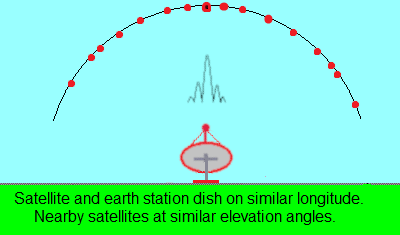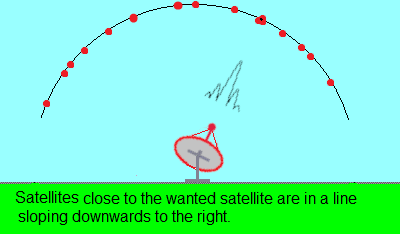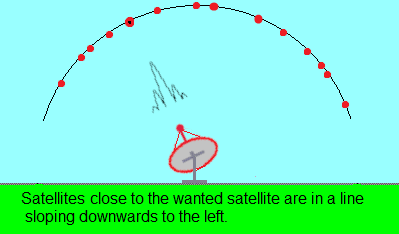|
Satellite dish pointing in the UK |
Elliptical satellite dish antenna orientation
In satellite communications, elliptically shaped dishes are often used in order to achieve a narrow main beam pattern and low side lobe levels in a direction along the wider diameter. The alternative is to use larger circular dishes, but smaller dishes are preferred as they less obtrusive.
It is desired to minimise the side lobes in the direction towards other satellites, adjacent either side along the geostationary orbit. This minimises interference to and from those satellites. In the case of exceptionally small satellite dishes, as used for satellite TV, the width of the main beam itself and the locations of the adjacent satellite are of importance and it may be possible to make the wider width of the elliptical dish such that the locations of the probable adjacent satellites fall in the nulls between the main beam and the first sidelobes.
When installing an elliptical dish it may often be possible to alter the orientation of the ellipse by tilting the entire dish clockwise or anticlockwise while facing towards the satellite.
In the case where the wanted satellite is at approximately the same longitude as your dish location, the satellite will be close to the top of the geostationary orbital arc as seen across the sky. The top of the geostationary orbit is horizontal and it is appropriate in this case that the wide dimension of the elliptical dish be sideways. See figure below:

The broad width of the dish is thus aligned along the orbit line. See the view above, as seen with you standing behind the dish and facing forwards towards the satellite in the sky. If you are in the northern hemisphere you are facing south. If you are in the southern hemisphere you are facing north.
This image below illustrates the case of a wanted satellite some way away from the highest point on the geo arc. The dish needs tilting so that its minimum sidelobes line up with the adjacent satellites.

The dish is tilted clockwise, as viewed with you behind the dish, in the direction towards the satellite and the dish larger diameter is roughly aligned along the line of the nearby satellites.
The appropriate tilt angle (+ positive) is the same as the skew or polarisation adjustment angle as calculated using the dish pointing calculator. Satellites with linear polarisation normally have the planes of polarisation parallel or at right angles to the geo orbit equator line.
If you are in the northern hemisphere your satellite is towards the south west. If you are in the southern hemisphere your satellite is towards the north east.

In this case your dish is tilted to the left so that the wider diameter matches the sloping line of the adjacent satellites.
If you are in the northern hemisphere your satellite is towards the south east. If you are in the southern hemisphere your satellite is towards the north west.
The diameter of the main beam is smaller with larger diameter dishes. In the case of an elliptical dish the main beam shape is normally also elliptical with the narrow dimension sideways, if the broad dimension of the dish is also sideways. With appropriate feed, there are also lower sidelobes along the wider dish diameter so less interference from and to adjacent satellites along the orbit line.
Updated text: 22 Jan 2025 to correct error about the view of the wanted satellite when the satellite is on similar longitude as the earth station dish. Many thanks to the visitor to this page who pointed out this error.
|
Page started 21 Nov 2007, amended 21 Oct 2025. |